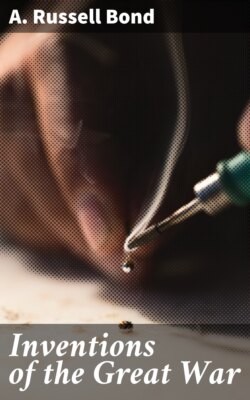Читать книгу Inventions of the Great War - A. Russell Bond - Страница 13
На сайте Литреса книга снята с продажи.
HAND-ARTILLERY
ОглавлениеTable of Contents
Trench warfare is really a close-quarters fight of fort against fort, and the soldiers who manned the forts had to revert to the ancient methods of fighting an enemy intrenched behind fortifications. Centuries ago, not long after the first use of gunpowder in war, small explosive missiles were invented which could be thrown by hand. These were originally known as "flying mortars." The missile was about the size of an orange or a pomegranate, and it was filled with powder and slugs. A small fuse, which was ignited just before the device was thrown, was timed to explode the missile when it reached the enemy. Because of its size and shape, and because the slugs it contained corresponded, in a manner, to the pulp-covered seeds with which a pomegranate is filled, the missile was called a "grenade."
Grenades had fallen out of use in modern warfare, although they had been revived to a small extent in the Russo-Japanese war, and had been used with some success by the Bulgarians and the Turks in the Balkan wars. And yet they had not been taken very seriously by the military powers of Europe, except Germany. Germany was always on the lookout for any device that might prove useful in war, and when the Germans dug themselves in after the First Battle of the Marne, they had large quantities of hand-grenades for their men to toss over into the trenches of the Allies. These missiles proved very destructive indeed. They took the place of artillery, and were virtually hand-thrown shrapnel.
The French and British were entirely unprepared for this kind of fighting, and they had hastily to improvise offensive and defensive weapons for trench warfare. Their hand-grenades were at first merely tin cans filled with bits of iron and a high explosive in which a fuse-cord was inserted. The cord was lighted by means of a cigarette and then the can with its spluttering fuse was thrown into the enemy lines. As time went on and the art of grenade fighting was learned, the first crude missiles were greatly improved upon and grenades were made in many forms for special service.
There was a difference between grenades hurled from sheltered positions and those used in open fighting. When the throwers were sheltered behind their own breastworks, it mattered not how powerful was the explosion of the grenade. We must remember that in "hand-artillery" the shell is far more powerful in proportion to the distance it is thrown than the shell fired from a gun, and many grenades were so heavily charged with explosives that they would scatter death and destruction farther than they could be thrown by hand. The grenadier who cast one of these grenades had to duck under cover or hide under the walls of his trench, else the fragments scattered by the exploding missile might fly back and injure him. Some grenades would spread destruction to a distance of over three hundred feet from the point of explosion. For close work, grenades of smaller radius were used. These were employed to fight off a raiding-party after it had invaded a trench, and the destructive range of these grenades was usually about twenty-five feet.
Hand-grenades came to be used in all the different ways that artillery was used. There were grenades which were filled with gas, not only of the suffocating and tear-producing types, but also of the deadly poisonous variety. There were incendiary grenades which would set fire to enemy stores, and smoke grenades which would produce a dense black screen behind which operations could be concealed from the enemy. Grenades were used in the same way that shrapnel was used to produce a barrage or curtain of fire, through which the enemy could not pass without facing almost certain death. Curtains of fire were used not only for defensive purposes when the enemy was attacking, but also to cut off a part of the enemy so that it could not receive assistance and would be obliged to surrender. In attacks upon the enemy lines, grenades were used to throw a barrage in advance of the attacking soldiers so as to sweep the ground ahead clear of the enemy.
The French paid particular attention to the training of grenadiers. A man had to be a good, cool-headed pitcher before he could be classed as a grenadier. He must be able to throw his grenade with perfect accuracy up to a distance of seventy yards, and to maintain an effective barrage. The grenadier carried his grenades in large pockets attached to his belt, and he was attended by a carrier who brought up grenades to him in baskets, so that he was served with a continuous supply.
